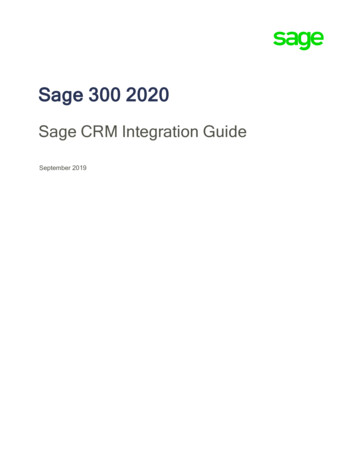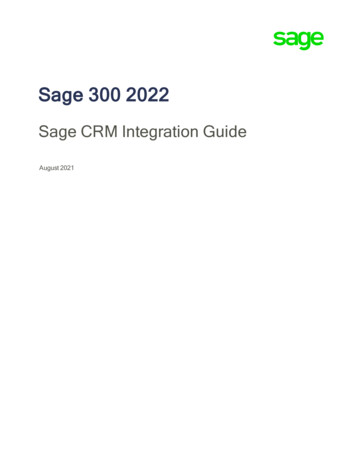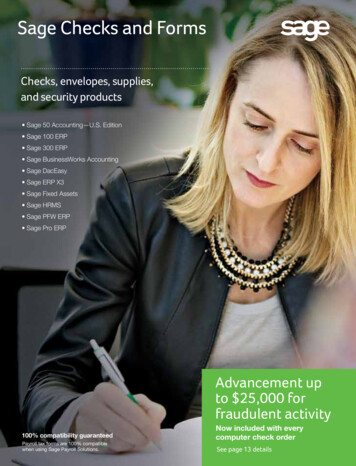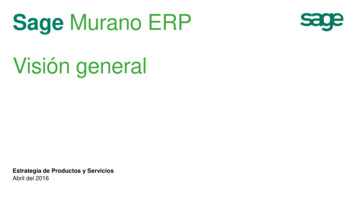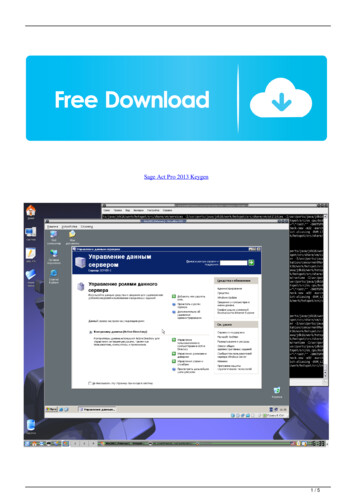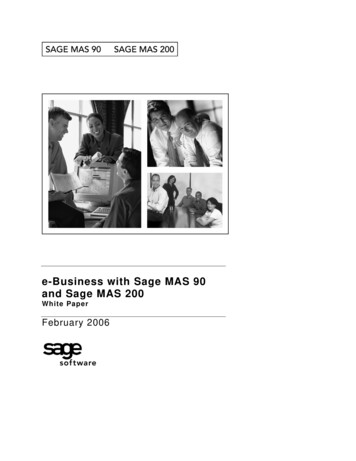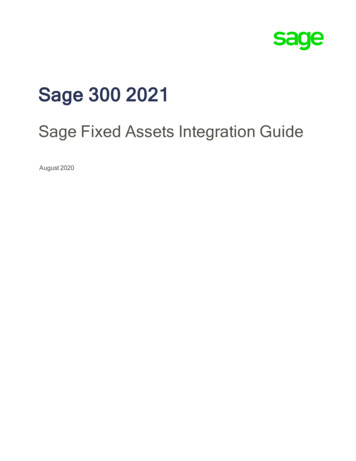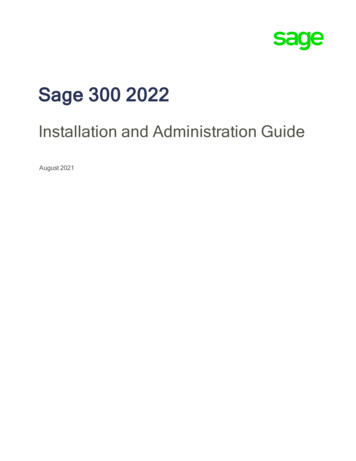
Transcription
CONTENT GUIDESage X3Solution Capabilities GuideProduct Version 12Document Revision 1.1 August 2019
Contents3.Financial Management47.User Workspace14.Supply Chain Management52.Mobile Web Apps36.Manufacturing55.Administration and Support42.Project management59.Cloud Connectivity44.Reporting and business analyticsThis document is for information purposes only and is intended solely toassist you in planning for the implementation and upgrade of the productfeatures described. It is not a commitment to deliver any material, code, orfunctionally, and should not be relied upon in making purchasing decisions.The development, release, and timing of any features or functionality describedin this document remains at the sole discretion of Sage.
FinancialManagement.Sage X3 Version 12 Capabilities Guide Version 12.0 Revision 1.1 August 20193
Financial Management1.1 Budgets and Accounting1.1.1 Functional domainscurrency are translated into a ‘ledger’ currency. Multi-ledger: Ability to define several ledgers for one company. Ledgers can be shared ordedicated. General ledger Account payable / Account receivable / Cash Cash managementcase, local rules are applied depending on the context. These rules can be defined using Cost accountinguser-designed settings or may include dedicated processes. ExpendituresModels and ledgers Budget and Commitments Each company is linked to an accounting model that defines the ledgers used (up to 10). Financial reporting A ledger is characterized by one currency, one calendar, one chart of accounts and analytical Fixed Asset management dimensions 1.1.2 Financial data model Sage X3 is multi-language, multi-company, multi- site, multi-currency, multi ledger, and The charts of accounts and dimensions can be shared ormulti-legislation by design. specific to several entitiesMulti-language: Ability to speak the language of users and partners. It includes the userinterface and descriptions. .Companies and sites Multi-site, multi-companyMulti-company: Ability to manage several companies in the same database. It enables Group of sites and companies may be defined for an aggregate crossed view (by activity,function, geographical location), in inquiries or reportsan organization to share the same repository while dedicating some data to one or Up to 9 analytical dimensions may be defined for a ledger, up to 20 analytical dimensions fora modelGeneral context Multi-legislation: Ability to manage several companies located in different countries. In thisseveral site/companies. Each company is associated with one accounting model and one legislationMulti-site: Ability to manage several structureswithin a company, due to business,. Automation of inter-site transactionsorganizational, or geographic needs. Automated inter-company transactions in purchases and sales modulesMulti-currency: Ability to manage transaction currency. The amounts in this transaction CurrenciesSage X3 Version 12 Capabilities Guide Version 12.0 Revision 1.1 August 20194
Financial ManagementCurrenciesAccounts Unlimited number of currencies and exchange rates, manually entered or imported Length of account fixed or variable, numeric or alphanumeric, configurable Unlimited number of rate types – daily, monthly, average, budget Validity date-controlled Currencies may be linked to accounts and business partners Restriction by site, company, group site Transactions entered in foreign currency, converted into the ledger currency Financial and quantity elements recorded Automatic rounding User definable management rules (class, matchable, centralized, collective, dimension(s), Automatic exchange variances when matchingtax management, default sense, normal sense of balance, transactions for debit/credit, Asset / liability conversion at end of period/year; actual or simulatedintercompany partner etc.)Calendars Propagation rules between ledgers A calendar per ledger; Up to 24 periods per calendar Up to 9 dimensions (e.g. department, cost center, product line, etc.) Year-initial period for carry forward and year-end period for closing adjustments Multi-level structures (pyramids), up to 99 levels, unlimited number of pyramids Monthly and annual closing process, with automatic recognition of upstreamBusiness partnertransactions, accruals, and functional controls JournalsUnique business partner identification, additional information based on roles (customer,supplier, carrier, factor, sales rep.) Unlimited number of journals Rules (payment terms, tax management) distributed per company and per role Pre-defined types (sales, purchases,inventory, miscellaneous operations, carry-forward,. Miscellaneous business partner, such as bank or bank accountsclosing), shared or specific to a ledger Unlimited number of addresses (Ordering, delivery, billing, payment, etc.) Validity date-controlled Unlimited number of bank identification numbers per address Close journals independent of period closure Linked business partner such as customer ship-to, bill-to, and pay- by as well as supplier Site, company, group of sites allowed. Frequent accounts, dis-allowed accountsbuy-from, invoice-from, and pay-to, factor, group and risk Risk management (commercial, financial), user definable controls on values outstandingSage X3 Version 12 Capabilities Guide Version 12.0 Revision 1.1 August 20195
Financial ManagementDimensions Status (temporary, definitive) Validity -controlled Simulated active or inactive Site, company, group of sites allowed Model templates Restricted combinations of accounts and dimensions, restricted combinations of User definable transactions, defined by/for the users, automating default values and controlsdimensions and dimensions Manual journal entries, batch entries Financial and quantity User-defined templates automating recurring journal entries Multi-level structures (pyramids), up to 99 levels, unlimited number of pyramids Automatically reversing journals Pre-defined distribution keys Automatic inter-site transactions and balancing of accounts on linked accounts A post entry, distribution process that distributes charges and products according to Automatic inter-company transactions and balancing of accounts on linked accountsuser definable and iterative rules. (Please check availability in your region)Quantity or financial (Example: Distribution of rent in proportion to area (m2) occupied Recurring journal entries (fixed, variable), with automatic balance calculationby cost centers) Automatic journal entries reversing at a user defined dateCalculated by quantity or costs (Example: Distribution of marketing charges in Automatic rounding rules in currency conversionsproportion of sales of product lines) Currency conversions selectable among fixed rate, lower-value, and higher value Electronic signature of journal entries (Detection of any changes in critical information afterIntercompany partner and flow Debit or credit default flow,. according to the account Inter-company partner management Pre-consolidated balance sheet and ledger justifyingby passing balance). inter-company transactions and aggregating the accounts according to the rules for theMatching is accompanied by the following automatic functions:consolidation chart of accounts1.1.3 G/L Accounting validation, whatever they have been made) .General characteristicsSage X3 Version 12 Capabilities Guide Version 12.0 Revision 1.1 August 2019Manual or automatic matching (by reference, description, ledger amount, currency amount, Automatic generation of matching variance below a user definable threshold Automatic generation of exchange variance for currency transactions Archiving of matching to restore the situation of matchable accounts to date6
Financial ManagementClosing Tax reporting management Automation of accruals: Invoices to be received, invoices to be issued, etc. Tax declaration process activation per legislation User definable controls of closing reports: Completeness of records, checking balances,1.1.4 Accounts payable / receivableetc.Invoicing Fiscal year-end closing Invoice types (invoice, credit note, debit note, proforma) per site or per company Unique numbering (supplier invoices) Automatic generation of adjustment journal entries account to account (optional) Legal information management Automatic generation of the result and the carry-forward Automatic calculation of open items based on the payment terms Generation of automatic journal entries from model templates with amounts calculated Automatic tax calculation (VAT, parafiscal)by user definable formulas (e.g. quoted part’s account balance multiplied by a Withholding taxes calculationcoefficient) Allocation of charges to dimensionsDeclarations (Please check availability in your region) Automatic inter-site transaction management Automatic inter-company transaction managementTax management On debit, on payment Recurring invoice management with alerts, workflows and traceability Tax prorate management Electronic signature of AR invoices (Detection of any changes in critical information after Suspension of tax ServicesOpen items management EU VAT VAT on pre-payment, on unpaid items Para-fiscal taxesvalidation, whatever they have been made). .Report for goods tax declaration per country/region (EU Intrastats) Report for services tax declaration (EU Intrastats)Automate the calculation of open items for invoices, from the shipment date and thepayment term Payment schedule management (unlimited number of open items for one invoice) Definable transactions for changing open items, according to user rights (Payment mode,Sage X3 Version 12 Capabilities Guide Version 12.0 Revision 1.1 August 2019due date, pay approval, dispute, etc.)7
Financial Management Consolidation or expand open itemsPayment process Approval for payment, with definable workflows Definition of banks and cash, unlimited numberCredit management Bank or cash entries Automated payment processing, including international context:Payable/receivable, factor, group and risk business partner management, which may ormay not be the same User definable processes, defining steps and controls User definable rules for calculating business and financial risk Automation of specific operations such as prepayments made/ received, User definable rules for calculating due amounts, workflow validation Charges/discount management Automatic user definable posting and matching Aged balance through inquiries with full upstream / downstream traceability, or Transfer/debit automation by automatic proposals submitted for validationcompensation, payment variances, bank chargesthrough reports Quick entry by picking open items Collection of due amounts by reminder campaign management Automation of inter-site, inter-business partner, inter-collective transactions User defined reminder campaign management rules, by representative, risk, group Payment in foreign currency, Payment in a currency other than the billing or bank currency.business partner, statistical family, etc. Mark business partners as remindable / non remindable and set minimum threshold, byAutomating cross-currency journal entries currencyPayment balance declaration to prepare periodic statistical declarations on non-residentpayments and receivables/liabilities Global reminder, global per. level, global per delay, detailed per invoice Automatic discount/charge and exchange variance management Letter, e-mail, telephone, fax, link to the customer service management to create tasks Prepayments with tax management and reportsautomatically Prepayments on order, with full/partial matching against the invoice Up to 9 levels of reminder, with definable text for each level Automation of unpaid postings: Calculation of charges for delayed payments,calculation of interest notes. bank charges management, charges re-invoicing, transfer to doubtful collective, tax adjustments Credit policy management and credit level messagingSage X3 Version 12 Capabilities Guide Version 12.0 Revision 1.1 August 20198
Financial Management Taking into account the local specific legal and fiscal rules for the country: Letter-check,draft, direct debit, domiciliation, transfer to be made, deposit items or payments according to user-defined search criteria User definable function to describe bank formats, delivering a library of formats readyReview the result of the automatic matching and process additional manual matches/entries if necessaryfor use Generate payments after completion of the matching Compliance with SEPA SCT and SDD for the Euro SEPA payment transactions Post these payments using the standard payment functions (Payment entry/Remittance Mandate management for direct debits (SDD), including managing mandates andgeneration)integrating mandates into sales and accounts receivable processFactoring Define XML bank files for direct debit or credit transfer when required by banks Receipt generation and printing Integration with Sage Pay to manage online, face-to-face, and phone payments Receipt posting(Available in the UKI only) Magnetic file generationBank reconciliation Payment notification Reconciliation (Bank G/L entries mark) Outsource payment collections from customers Bank statement reconciliationEmployee expenses Bank statement entered or imported. Structure of the bank statement file is user Personal information entriesdefinable with a dedicated function. It is also easy to include new formats. Decentralized expenses entries – access rights and confidentiality Automatic bank statement .reconciliation (Statement vs ledger) User definable cost types (Travel, hotel, taxi, etc.) Tools for manual reconciliation: sorting and searching by amount, type, description, User definable caps on reimbursement, user defineddate, reference (N check, etc.) thresholds for reimbursement (e.g. km, etc.)Advanced Bank Statement Tax management Import bank statement files. Structure. of the bank statement file is user definable with Reportsa dedicated function. User definable workflow for validationRun a process to automatically match each bank operation in the statement to open Automatic user definable posting Sage X3 Version 12 Capabilities Guide Version 12.0 Revision 1.1 August 20199
Financial Management Control reporting Budgets transactions by direct entry or by updated records for tracking the changes Cash forecast and bank positions User definable transactions Translation of sales and purchase documents in future cash issue/entry Automatic distribution of an annual budget per period, with seasonally adjusted distribution One-off and recurring additional events (payroll, taxes, etc.) with rules management Analysis of the future cash position by aggregating issues or entries with the currentrules bank positionsAutomatic procedure for creating a budget version from another version, or a budget byanother. Definition of budget formulas (deferral of the initial budget, actual, reassessment byExtension to expert modulescoefficients, etc.) Transfer to treasury cash flow forecasts, with user definable information Short term open items: payments processed Budget control from commitments, simultaneously on up to 10 budgets Medium term open items: Image of unbalanced open items User definable workflow validation of commitments, with signature approval cycle Transfer of cash balance to accountingdepending on whether the budget is exceeded or not1.1.6 Budgets Analytical budgets Management of key responses and actions, if no appropriate response, if the requiredresponse time is exceeded, escalation, etc.Definition of budgets, unlimited number, based on: Standard inquiries comparing the budget, commitments and actuals, with a configurable Level: company or sitelevel of detail, audit trail justifying accumulation by detail, financial data extraction including Currencybudget records, implementation of business intelligence standard universes Calendar, which can be different from the G/L calendar (period, start and end).Operational budgets Chart of budget accounts, which may be dedicated, or shared or derived .(grouping) from G/L or analytical ledger Up to 9 crossed dimensions that. may be dedicated, or shared or derivedFor a budget, unlimited number of versions, with a status (development, active, closed)Setting budget structures and roles (managers, recipients, hierarchical structure of control,reporting and approval) (grouping) from G/L or analytical ledger For charges:Split budget by projects, envelopes, exercises, budget lines. Annual or multi-year envelops.Multi-year budgets are particularly usable for investment budgets. Sage X3 Version 12 Capabilities Guide Version 12.0 Revision 1.1 August 2019Configurable workflow for approving various budget levels10
Financial Management Reserves management, outcome amounts Expense control from commitments, electronic approval Revisions, transfers between budgets Procedure for closing with user definable carry-forwards Chart of accounts to determine economic depreciation Off-budget lines management fiscal plan to determine accelerated depreciation or claw back fiscal plan to determine deferrable depreciation and manage deferred depreciationmodel in a currency, according to a financial year and interim period schedule Expenses commitments User definable function – input or import Linked to the purchase transactions, optional generation of pre-commitments (fromDepreciation context based on Accounting data model to manage a Fixed assets data Accounting and fiscal depreciation context linked to the Company accounting data model:IAS/IFRS depreciation context linked to the IAS/IFRS accounting repository (consolidatedaccounts)purchase requests), generation of commitments (from purchase orders) Ability to manage up to 15 depreciation plans per fixed asset On request/order date or receipt forecast dateDepreciation methods With/without non-deductible tax Pre-commitments balance while ordering, commitment balance while receiving orLarge list of depreciation methods (Straight line, Declining, Residual, Gradual, ProductionUnit, Constant, Accelerated, etc.)invoicing Depreciation method management by non-financial unit,Commitment control, with user definable signature workflow, which may be different determined by the rate of fixed asset usagedepending on whether the budget is exceeded or not Option to configure other depreciation methods Carry-forward of commitmentsfrom one year to another. Depreciation basis and method specific to each plan User definable reporting comparing budget, pre-commitment, commitment and actualAssociation of values 1.2 Fixed Assets1.2.1 Fixed asset management framework.Consistency of depreciation methods via an identification system depending on the value: of the Fixed asset accounting code or the Fixed asset familyFixed asset management in accordance with IAS/IFRSExtended fixed asset recordDepreciation context and plans Sage X3 Version 12 Capabilities Guide Version 12.0 Revision 1.1 August 2019Dual valuation and dual account posting, according to the Company accounting repository11
Financial Managementand according to the Group accounting repositoryor invoices or due to adjustments of VAT deductions Identification of Type of holding: “Owned”, “Leased”, “Rented”, “Franchised”, “Projected” Commissioning of fixed assets Business sector to manage VAT deduction rules Allocation of Fixed assets: geographical and analytical Visibility of the various depreciation plans on a configurable timescale: option of Creation and updating of depreciation plansautomatic depreciation plan calculation Traceability of physical and analytical movements Traceability of renewals for “Franchised” assets Link to related physical element(s) for barcode registration and control stock count Change of method: duration, mode, prospective or retroactive, in accordance withplan standards Impairment management, for recording a loss in addition to the loss recorded throughdepreciationpurposes Revaluation management, according to market value or by application of a coefficient Link to contract for “Leased” and “Rented” assets Splitting of fixed assets, for reallocation or partial issue Link to production plan for assets depreciated by Intra-group transfers: spinoff, merger and demerger operations. Option of simulation before Non-financial unit Management of data relating to vehicles in order to produce a preparatory statementexecution. for declarationAsset issue (sale, disposal, loss), with calculation of capital gain or loss 1.2.2 Fixed asset life cycleThese actions can be carried out individually in a fixed asset record, or applied inbatch mode to a selection of assets Traceability of Capitalized expenditure. Taken from records of purchase invoices and third-party supplier invoices1.2.3 Interim statements and closing Creation of Fixed assets from Capitalized expenditure Splitting of Capitalized expenditure Grouping of Capitalized expenditure . Discounting of depreciable costs and depreciation bases, due to additional credit notes Ability to run closing process in simulation modeInterim statements according to the period breakdown of the Accounting repository, forprovisional or final posting of the depreciation and movements for the periodFixed asset breakdown managementTraceability and reporting of fixed asset and depreciation transactions by account and byheadingSage X3 Version 12 Capabilities Guide Version 12.0 Revision 1.1 August 2019Journal of detailed account entries12
Financial Management Closure of fiscal year after application of annual VAT deduction adjustments for partialaccounting data modeltaxpayers and registrants Option of processing the first interim statements for the following fiscal year beforeexercised by acquisition of the equipmentclosure of the current fiscal year Ready-to-use reports to obtain your fixed asset position and movements; BI universeEnd of contract management: equipment returned to lessor or purchase option with reportsManagement of equipment subsidies: 1.2.4 Fixed asset stock countProduction of financial commitment reportsCalculation of subsidies allocated to investment projects, posting to fixed assets,calculation and posting of the reintegration. Records of registered physical elements1.2.6 Franchised asset management Physical element bearing the barcode registration, linked to the fixed asset: n physical For equipment made available to the company by a franchisor, generally a local authority:elements per fixed asset Management of franchise contracts and riders: extension of the franchise with effect on Allocation and movement management at Physical element level, with a validationfixed assetsphase to pass the movement on to the fixed asset: Change of location; Asset issue Calculation and posting of provisions for renewalManage control stock counts, to check the validity of fixed asset accounts Financial depreciationCollection of registrations with a Pocket PC (Windows mobile) fitted with a Renewal of franchised assets and traceability of renewalsbarcode reader and Sage Inventory Tools software to manage stock counts Customer invoice creation on sale of fixed asset Automatic comparison. of stock count file and Physical elements records in orderto identify and correct variances or suggest updates1.2.5 Fixed asset financing For leased or rented equipment: management of the lease or rental contract: Identification and characteristics. of the contract; payment scheduleGeneration of account entries for the company accounts and consolidatedaccounts: reprocessing of the fee if the asset is depreciated in the IAS/IFRSSage X3 Version 12 Capabilities Guide Version 12.0 Revision 1.1 August 201913
Supply ChainManagement.Sage X3 Version 12 Capabilities Guide Version 12.0 Revision 1.1 August 201914
Supply Chain Management2.1 Purchasing2.1.1. Purchasing data model Commercial history inquiry Supplier prices inquirySupplier reminder by undelivered orders on outstanding products Supplier Supplier breakdown: ordered, invoicing, paid and groupProduct categories Multi-address and multiple bank details Grouping of products with similar management rules Management of contacts by address Rapid creation of a product inheriting the default management rules and values for the Management of discounts/bank charges Multi-type and multi-due date payment modes, with management of alternative Association of management rules relating to inputs and issuespayment modes Association of configurable allocation rules Commercial and financial monitoring Association of configurable valuation rules Minimum order valueProducts Multi-line orders In stock or not, management of serial numbers, lot numbers and sub-lot numbers Supplier quality monitoring Default supplier per product and per product/site Supplier ranking Version number (Major and minor version) Commercial products, service provision or sub-contract provision Supplier work-in-progress control:Real-time work-in-progress. status VAT and parafiscal tax management Configurable work-in-progress control (hold/release, etc.) Product reference, product description, units, minimum purchase quantities customizable Inquiries with audit trail ranging from general to detailed:categoryby supplier Commercial risk analysis by site, company or folder Identification of direct order suppliers by product Financial risk analysis by site, companyor folder. Inquiries with audit trail ranging from general to detailed Multi-collective account inquiry Price catalogue inquiry Recent transactions inquiry Stock inquiry by siteSage X3 Version 12 Capabilities Guide Version 12.0 Revision 1.1 August 201915
Supply Chain Management Product cost inquiry Supplier catalogue import Competing product inquiry and association Advanced purchasing cost management can include supply chain costs in total purchase Product installed base inquirycostsUnits2.1.2 Inter-company/inter-site transactions Stock unitsAutomated management of commercial transactions between sites belonging to the same Packing units with fixed or variable conversion factorscompany or between sites belonging to different companies: Commercial units (sales, purchases) Inter-company pricing Configurable unit conversion rules for taking from another unit: unpacking, incomplete Retail sale orders generated automatically from purchase ordersunit management, unit splitting Contract orders generated automatically from purchase ordersStock label management by packaging Sub-contract ordersPrices & Discounts Inter-company invoicing with generation of purchase invoice control on customer site Configurable price structure by supplier Management of logistical transactions between sites belonging to the same company or Configurable multi-criteria prices Price management by currency, coefficient, quantity or Inter-site deliveries configurable formula Inter-site receipts with inheritance of the stock characteristics of the corresponding Inter-company prices Prices applicable by date slots (promotions) Prices applicable by line and/or by document Discounts and costs by line and by order, as a value, as a percentage, as a cumulative Immediate inter-site stock movements for sites geographically close to each othertotal, cascaded Setup movement rules and processes to declare subcontracting flows between sites belonging to different companies:deliveries. Simulation of price application Archive of prices and discounts applied Customer or inter-site returns with inheritance of the stock characteristics of thecorresponding supplier returns2.1.3 Commercial documents Sage X3 Version 12 Capabilities Guide Version 12.0 Revision 1.1 August 2019User-configurable entry transactions (quick entry)16
Supply Chain Management Configurable purchasing cycle: Every step in the transportation of goods can be defined by a cost with different cost RFQ (Request for Quotation)/Purchase request/Ordercalculation Purchase request/RFQ/Order The cost structure is the list of costs for transport, including all of the steps. RFQ/Order Cost-structure affected by product, product-supplier, or product-supplier-site by site Order/Invoice Management of product costs on the shipment Order/Receipt/Invoice2.1.5 Request for Quotation/Call for tenders Order/Invoice/Receipt Request management (multi-product and multi-supplier) Direct invoice Request printout by supplier Automatic or manual numbering Taking purchase requests into account Unlimited links between documents Tender comparison User definable printable text in document header, footer and lines Responses and reminders Custom order code identification by line Price line generation2.1.4 Advanced Purchasing Costs Management2.1.6 Expenditure authorization APC (Advanced Purchasing Costs) enables users to foresee the purchase costs for Real-time budget monitoring managementinternational imports using international standards (incoterm) or inland purchases Budget control (with warning or freezing) by value or quantity, with override limit by userEstimate the purchase cost. of a good, along with the logistic operations included in the Configurable signature processes for purchase requests, orders and contract orders with supply chain additional process in the event of budget overrun2 methods of managing APC: Main and deputy signatory management, switching Landed cost coefficient Workflow engine incorporated into the process Cost Structure Automatic generation of pre-commitment (purchase request) and commitment (order) .Reconciliation between the Cost and the Additional Invoice On supplier order: purchase cost by line or total, detail by cost nature entriesSage X3 Version 12 Capabilities Guide Version 12.0 Revision 1.1 August 2019Disengagement from the previous stage at every stage of the transaction17
Supply Chain Management Automatic generation of entries and direct posting of realized amounts on budget line(invoices receivable,
Fixed Asset management 1.1.2 Financial data model General context Sage X3 is multi-language, multi-company, multi- site, multi-currency, multi ledger, and multi-legislation by design. Multi-language: Ability to speak the language of users and partners. It includes the user interface and descriptions.
